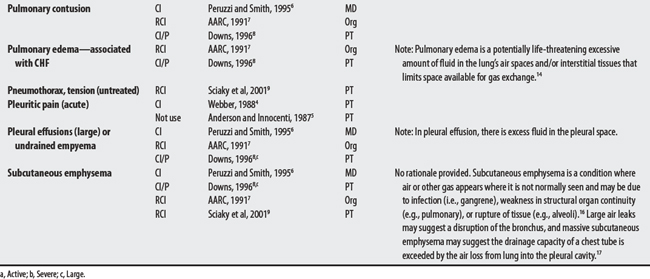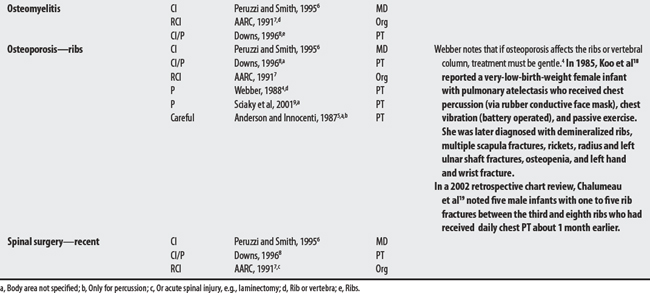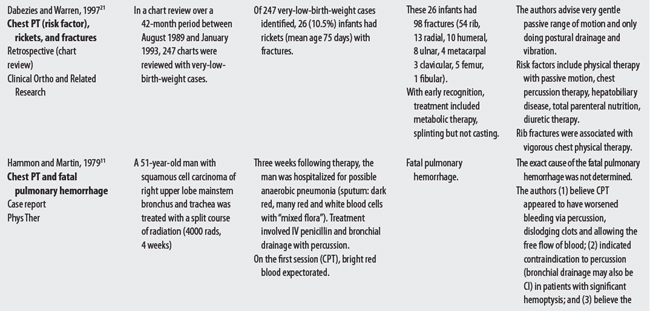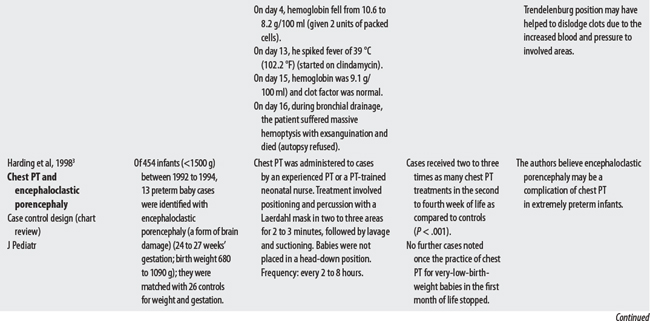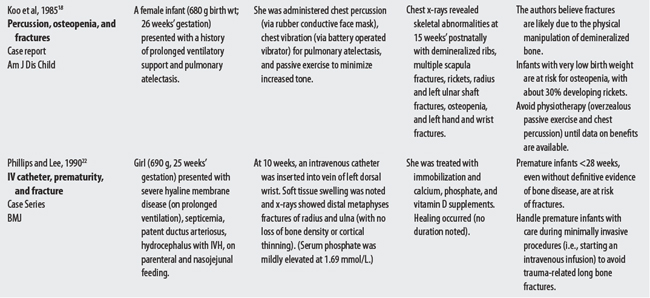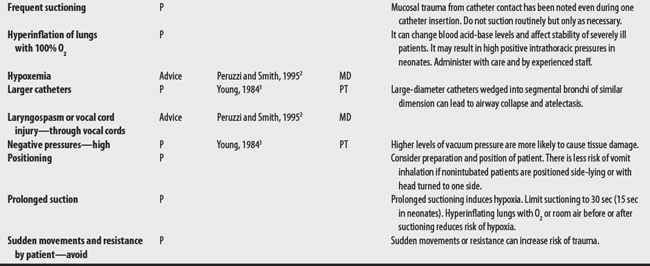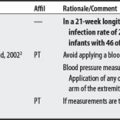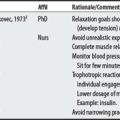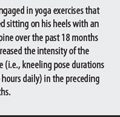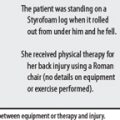Chapter 36 Manual/Mechanical Techniques
36.1 Percussion and Vibration of the Chest
OVERVIEW.
Percussion is a manual technique of administering rhythmic, alternating, cupped-hand movements over lung segments to dislodge and mobilize secretions that adhere to lung tissue. Vibration is a technique of administering small-amplitude rapid shaking over lung tissue to mobilize secretions.1 In both techniques, forces are applied over the thorax.
OTHER CONCERNS: INTRAVENTRICULAR HEMORRHAGES IN PREMATURE INFANTS.
In a 1987 RCT, Raval et al2 reported a higher incidence of IVH (grade 3 and 4) in preterm infants, less that 2000 g, with respiratory distress syndrome who received vibration, percussion, postural drainage, and suctioning than in controls who received only suctioning. In a 1998 case control design (chart review), Harding et al3 noted that of 454 infants, 13 preterm babies who had received two to three times as many chest PT treatments in the second to fourth week of life as compared with controls had encephaloclastic porencephaly (a form of brain damage).
CONTRAINDICATIONS AND PRECAUTIONS
A00-B99 CERTAIN INFECTIONS AND PARASITIC DISEASES
D50-D89 DISEASES OF BLOOD AND BLOOD FORMING ORGANS AND CERTAIN DISORDERS
F00-F99 MENTAL AND BEHAVIORAL DISORDERS
G00-G99 DISEASES OF THE NERVOUS SYSTEM
I00-I99 DISEASES OF THE CIRCULATORY SYSTEM
J00-J99 DISEASES OF THE RESPIRATORY SYSTEM
L00-L99 DISEASES OF THE SKIN AND SUBCUTANEOUS TISSUE
M00-M99 DISEASES OF THE MUSCULOSKELETAL SYSTEM AND CONNECTIVE TISSUE
S00-T98 INJURY, POISONING, AND CERTAIN OTHER CONSEQUENCES OF EXTERNAL CAUSES
1 Kisner C, Colby LA. Therapeutic exercise: foundations and techniques, ed 3. Philadelphia: F.A. Davis, 1996.
2 Raval D, Yeh TF, Mora A, et al. Chest physiotherapy in preterm infants with RDS in the first 24 hours of life. J Perinatol. 1987;7(4):301-304.
3 Harding JE, Miles FK, Becroft DM, et al. Chest physiotherapy may be associated with brain damage in extremely premature infants. J Pediatr. 1998;132(3 Pt 1):440-444.
4 Webber BA. The Brompton hospital guide to chest physiotherapy, ed 5. Oxford: Blackwell Scientific, 1988.
5 Anderson JM, Innocenti DM. Techniques used in chest physiotherapy. In Downie PA, editor: Cash’s textbook of chest, heart, and vascular disorders for physiotherapists, ed 4, Philadelphia: J.B. Lippincott, 1987.
6 Peruzzi WT, Smith B. Bronchial hygiene therapy. Crit Care Clin. 1995;11(1):79-96.
7 AARC. Clinical Practice Guidelines. Available at: http://www.rcjournal.com/online_resources/cpgs/cpg_index.asp. Accessed November 16, 2005
8 Downs AM. Physiological bases for airway clearance techniques. In Frownfelter D, Dean E, editors: Principle and practice of cardiopulmonary physical therapy, ed 2, St. Louis: Mosby, 1996.
9 Sciaky A, Stockford J, Nixon E. Treatment of acute cardiopulmonary conditions. In Hillegass EA, Sadowsky HS, editors: Essentials of cardiopulmonary physical therapy, ed 2, Philadelphia: W.B. Saunders, 2001.
10 Starr JA. Chronic pulmonary dysfunction. In O’Sullivan SB, Schmitz TJ, editors: Physical rehabilitation and treatment, ed 4, Philadelphia: F.A. Davis, 2001.
11 Hammon WE, Martin RJ. Fatal pulmonary hemorrhage associated with chest physical therapy. Phys Ther. 1979;59(10):1247-1248.
12 Irwin S, Tecklin JS. Cardiopulmonary physical therapy. St. Louis: Mosby, 1995.
13 Hammon WE, Connors AFJr, McCaffee R. Cardiac arrhythmia during postural drainage and chest percussion of critically ill patients. Chest. 1992;102(6):1336-1341.
14 Goodman CC. The respiratory system. In Goodman CC, Boissonnault WG, Fuller KS, editors: Pathology: implications for the physical therapist, ed 2, Philadelphia: Saunders, 2003.
15 Connors AFJr, Hammon WE, et al. Chest physical therapy. The immediate effect on oxygenation in acutely ill patients. Chest. 1980;78(4):559-564.
16 Samlaska CP, Maggio KL. Subcutaneous emphysema. Adv Dermatol. 1996;11:117-151. 152
17 Fishman AD, Elias JA, Fishman JA, et al. Fishman’s manual of pulmonary diseases and disorders, ed 3. New York: McGraw-Hill, 2002.
18 Koo WW, Oestreich AE, Sherman R, et al. Radiological case of the month. Osteopenia, rickets, and fractures in preterm infants. Am J Dis Child. 1985;139(10):1045-1046.
19 Chalumeau M, Foix-L’Helias L, Scheinmann P, et al. Rib fractures after chest physiotherapy for bronchiolitis or pneumonia in infants. Pediatr Radiol. 2002;32(9):644-647.
20 Crane L. Physical therapy for neonates with respiratory dysfunction. Phys Ther. 1981;61(12):1764-1773.
21 Dabezies EJ, Warren PD. Fractures in very low birth weight infants with rickets. Clin Orthop Rel Res. 1997;335:233-239.
22 Phillips RR, Lee SH. Fractures of long bones occurring in neonatal intensive therapy units. BMJ. 1990;301:225-226.
36.2 Suctioning
1 Doran BRH. Intensive Therapy—Apparatus. In Downie PA, editor: Cash’s textbook of chest, heart, and vascular disorders for physiotherapists, ed 4, Philadelphia: J.B. Lippincott, 1987.
2 Peruzzi WT, Smith B. Bronchial hygiene therapy. Crit Care Clin. 1995;11(1):79-96.
3 Young CS. Recommended guide lines for suction. Physiotherapy. 1984;70(3):106-108.
4 Crane L. Physical therapy for neonates with respiratory dysfunction. Phys Ther. 1981;61(12):1764-1773.










